The Stage 3 redevelopment of Breakout Creek includes the creation and installation of 9 stunning Kaurna artworks, created by artist Allan Sumner and his team.
Find out more from Allan about the cultural significance of these sculptures:
1. Ngarlawirri Sculpture (Hand and Club Sculpture)

The Ngarlawirri sculpture, symbolising the long, heavy club, powerfully represents the resilience and strength of the Kaurna people in the face of colonial violence. For the Kaurna, the impact of European explorers, whalers, sealers, and ultimately the British settlers of 1836 was devastating, leading to profound changes in their way of life. The Kaurna were among the first to feel the full force of colonisation in what is now South Australia.
Despite the Letters Patent acknowledging the rights of 'Aboriginal natives,' the land rights of the Kaurna were largely ignored by colonial authorities. The brutal reality of the settlers’ arrival was not just about the seizure of land but also the destruction of their traditional way of life. The Kaurna resisted in various ways, with some warriors fighting fiercely to protect their territory, culture, and people.
The Ngarlawirri sculpture serves as a tribute to that strength – standing as a powerful symbol of resistance, survival, and the ongoing connection of Kaurna people to their land and culture. It speaks not only to the history of their struggle but also to the enduring spirit of the Kaurna people as they continue to fight for recognition, justice, and the preservation of their heritage.
2. Wittonga Witu Sculpture (Bulrushes Sculpture)
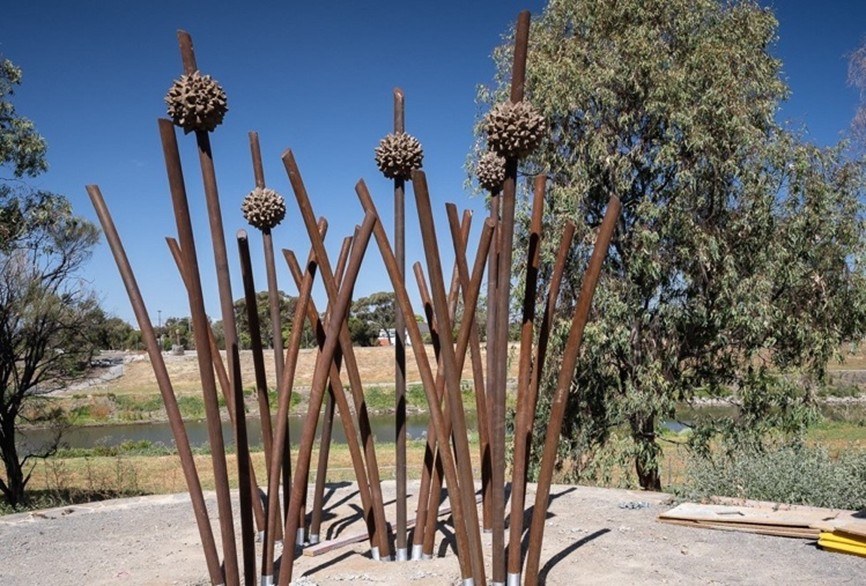
The Fulham Reedbeds, also known as 'Wittonga' (meaning 'reed place' in the Kaurna language), was a significant wetland system located along the coast of what is now Adelaide, South Australia. This area was nourished by the Karrawirra Pari (River Torrens), which emptied into a network of freshwater wetlands that extended from Glenelg to Semaphore, behind coastal dunes.
These wetlands were an important resource for the Kaurna people, providing filtered freshwater which supported both local flora and fauna, as well as the Aboriginal communities who relied on these wetlands for sustenance. The abundant natural resources, including fish, freshwater plants, and game, made the area an ideal place for Aboriginal occupation. The Kaurna people, who inhabited the Adelaide Plains, would have used these wetlands not only as a source of food but also as a place for cultural practices and social life.
The system of reedbeds, or Wittonga, played a crucial role in maintaining the ecological balance of the region, filtering water and supporting biodiversity. However, with European settlement and urban development, much of the wetland area has been lost or altered, leading to changes in both the natural environment and the ways in which the Kaurna people interacted with the landscape.
In this context, the Fulham Reedbeds serve as a reminder of the connection between the Kaurna people and the land, highlighting the importance of preserving and understanding the traditional knowledge and environmental practices that sustained Kaurna communities for thousands of years.
3. Ngudlitidli Nuinpi Sculpture (Lamprey Sculpture)
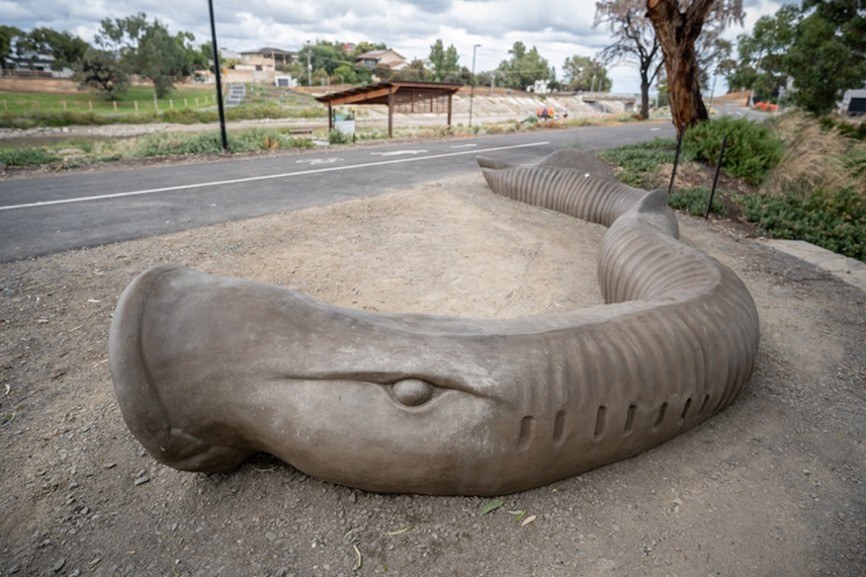
The pouched lamprey, or ngudlitidli nuinpi in the Kaurna language, is a remarkable and historically significant species, both ecologically and culturally. Its life cycle, which spans across both freshwater and saltwater environments, reflects the complex interconnections of aquatic ecosystems, highlighting its role in the health and balance of local biodiversity. While the lamprey's parasitic feeding habits may seem unsettling, they are a natural part of the life cycle of many aquatic species. The lamprey's unique anatomy, particularly its sucker-like mouth, allows it to latch onto and feed from host fish, playing a role in regulating the populations of those species.
Unfortunately, the dwindling numbers of the pouched lamprey in South Australia, and its absence from the River Torrens since 2008, reflect a broader crisis in the region's aquatic habitats. The decline of not just the lamprey but also other native fish species underscores the pressure that local waterways are facing, likely driven by pollution, habitat destruction, and climate change. With only eight native freshwater species remaining in the Torrens, and many of those facing extinction risks, the preservation of the pouched lamprey has become a symbol of the need for urgent conservation efforts.
For the Kaurna people, the ngudlitidli is more than just a biological entity – it holds cultural significance, reflecting the deep, historical ties between Indigenous communities and the natural world. It’s a reminder of how much knowledge and respect for the environment has been embedded in Indigenous cultures for millennia. The decline of such species, therefore, not only represents an ecological loss but also a cultural one, as the practices, stories, and spiritual connections tied to these creatures become endangered as well.
Conservation efforts to protect species like the pouched lamprey and other native fish are crucial, not only for the restoration of biodiversity but also to safeguard the cultural heritage of the Kaurna people and communities in the area.
4. Wardli pulthu Sculpture (Shellfish Midden Site)
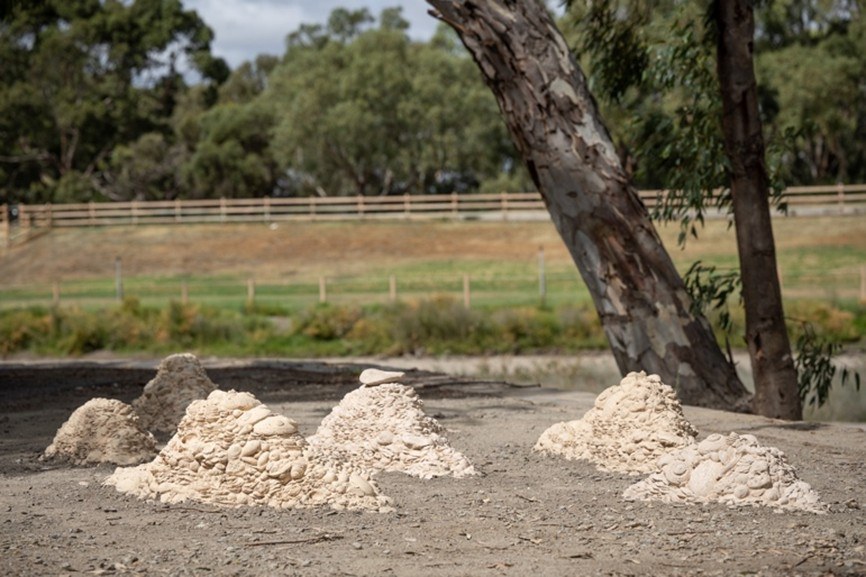
The term Wardli pulthu refers to a traditional Kaurna site where a camp or habitation used to be, often marked by the presence of shell middens. These shell middens are an important part of the Kaurna people's cultural heritage, found along the Adelaide coastline and serving as evidence of long-term occupation and resource use.
Shell middens, which are deposits of discarded shells from consumed shellfish, offer a glimpse into the daily life of the Kaurna people. The middens are usually found in locations such as coastal dunes, scrublands, woodlands, and even rock shelters. They tend to be situated near food-rich environments like rocky or sandy shores, coastal wetlands, river mouths, and estuaries, places where both marine and terrestrial resources would have been plentiful.
The Kaurna people’s diet was diverse, and the shell middens reflect this, not only containing shells from molluscs, but also remnants of fish, seals, and kangaroo. Additionally, the archaeological sites can include charcoal from fires, hearthstones, and various tools made from stone and bone. These cultural items provide insight into the technological and social practices of the Kaurna people.
Overall, these middens are invaluable for understanding the historical relationship between the Kaurna people and their environment, as well as their practices around resource management, food gathering, and cultural expression.
5. Winaityinaityi Story Poles

Winaityinaityi: The word for 'birds' in the Kaurna language.
Pole 1 – The yellow-tailed black cockatoo, known as Calyptorhynchus funereus, holds great cultural significance for the Kaurna people of South Australia, where it is called 'Wilampa' or 'Tiwu'. This bird is not only an important totem but also deeply connected to the land and the environment, particularly the forests where it resides.
The name 'Wilampa' or 'Tiwu' refers to the distinctive yellow or white markings found on the tail feathers of the cockatoo, which is a striking feature of the species. These cockatoos are known for their intelligence and social nature, and they play a role in the local ecosystem, particularly through their feeding habits. They are often seen foraging for seeds, especially those from pinecones, which is a critical part of their diet.
For the Kaurna people, the yellow-tailed black cockatoo is more than just a bird – it's a symbol that represents important cultural connections to the land, the spirit world, and the broader ecosystem. The bird’s strong connection to forested areas is also reflective of the Kaurna people's deep understanding of the natural environment and their relationship with the land.
In addition to their symbolic role, the yellow-tailed black cockatoo is also recognised for its endangered status. Habitat loss, including the destruction of forests and the removal of pine trees, has placed pressures on their population, making their conservation a priority in modern environmental efforts.
The reverence for Wilampa/Tiwu illustrates the Kaurna people's respect for the natural world and their commitment to the stewardship of the land, as well as their deep cultural ties to the animals that inhabit it.
- Pole 2 – Wirltu, the wedge-tailed eagle, holds deep cultural significance for the Kaurna people of the Adelaide Plains. In Kaurna storytelling, the eagle symbolises ambition, always striving to soar higher. Its foot represents the Southern Cross constellation, while its claws form part of the Wilto constellation, linking the eagle to the sky and reinforcing the Kaurna belief in the interconnectedness of land, spirit, and the cosmos. The eagle’s flight inspires the Kaurna people to reach for greater goals, embodying resilience, and the pursuit of higher knowledge.
- Pole 3 – The Kurraka, or magpie, holds significant cultural importance in Kaurna (the Indigenous people of the Adelaide Plains) culture. Known for its striking black-and-white plumage and melodious calls, the magpie is considered a messenger between the physical and spiritual worlds. In Kaurna tradition, the magpie is often seen as a protector, guiding people and communicating important messages. Its territorial behaviour, especially during the breeding season, is also seen as a symbol of strength and vigilance. The magpie’s role in controlling insects and maintaining balance in the environment further underscores its value in the Kaurna worldview.
- Pole 4 – In Kaurna culture, Yaltu the pelican symbolizes patience and teamwork. The pelican's graceful hunting and occasional cooperative fishing reflect qualities of perseverance and unity. Admired for its ability to coexist peacefully with other wildlife, Yaltu embodies the balance between individuality and collaboration, values that are deeply rooted in Kaurna traditions.
- Pole 5 – Ngungana, the kookaburra, is native to the coastal regions of southern Australia and plays a significant role in Kaurna culture. Revered for its distinctive laughing call, the kookaburra is not only an important figure in the natural landscape but also deeply embedded in the spiritual and cultural practices of the Kaurna people. In Kaurna culture, the kookaburra's call is often interpreted as a symbol of connection to the land and the ancestors. It is associated with communication, both as a messenger and as a means of keeping the community connected to the natural world. The bird is often seen as a guardian spirit, one that provides guidance and protection.
6. Painted Cultural Story Poles

These painted story poles highlight the deep connection between the Kaurna people and their traditional land and waters, as well as the impact of European colonisation on these environments. Each of the places mentioned – Wittonga, Karrawirra Pari, and Wauwa – reflects an intimate relationship with nature, where the land, water, and wildlife were central to Kaurna life.
- Story Pole 1 – Wittonga ('reed place'): This wetland environment was rich with life and integral to the Kaurna people’s sustenance and cultural practices. The imagery of birds, butterflies, fish, yabbies, and woven baskets evokes the abundance and interconnectedness of the ecosystem. The Kaurna lived in harmony with the land, using its resources in a sustainable way for food, tools, and shelter. The inclusion of Kaurna campsites in this landscape also emphasises the role of the land in supporting not just physical survival, but community life and cultural practices.
- Story Pole 2 – Karrawirra Pari ('red gum forest river'): The River Torrens, known in the Kaurna language as Karrawirra Pari, was more than just a watercourse – it was a crucial resource and a spiritual site. The Kaurna people's Dreaming stories, which are foundational to their understanding of the world, were intertwined with the river, giving it cultural and sacred significance. The disruption caused by European colonisation, where the river was transformed into a 'city river' and polluted in the process, represents a loss of both a physical and cultural resource. The painted pole in this case symbolises the landscape as it was before European occupation, restoring the Kaurna people's spiritual and ecological connection to the river.
- Story Pole 3 – Wauwa ('seashore'): The Kaurna people lived along the seashore, especially in the summer months, where abundant marine life provided food and materials. Fish, crabs, and shellfish were staples, but the seashore also offered resources for tools, trade, and cultural activities. The seashore, with its seasonal abundance, symbolises the dynamic and seasonal nature of Kaurna life, where the landscape provided in ways that were both practical and spiritual.
7. Ibis Feather Sculpture
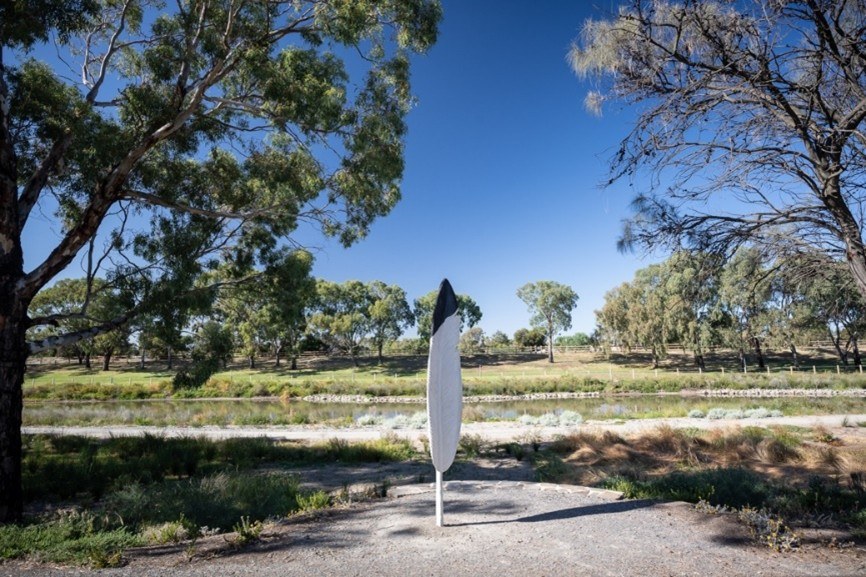
The story of Tjilbruke, also known as the Ibis Man, is a deeply significant and spiritual narrative within Kaurna culture, originating from the traditional lands of the Kaurna people, who are the traditional custodians of the Adelaide Plains in South Australia.
Tjilbruke’s journey is one of profound loss and transformation, and it encapsulates themes of grief, healing, and the creation of the land itself. According to Kaurna dreaming, Tjilbruke was a creator ancestor who shaped the landscape of the region while mourning the death of his nephew, Kulultuwi.
The Story of Tjilbruke and Kulultuwi:
Kulultuwi, Tjilbruke’s nephew, tragically broke a taboo, or kuinyunta, by eating the flesh of the kardi (emu), an act that was forbidden within their culture. This transgression led to Kulultuwi's untimely death. Overcome with grief, Tjilbruke journeyed across the land, weeping for his lost relative. His sorrow was so profound that his tears formed the rivers, lakes, and wetlands of the region, shaping the physical landscape.
The Spiritual Symbolism of the Feather Shape:
The symbol of the feather, often associated with Tjilbruke, is a powerful representation of his spiritual journey. The shape of the feather is said to represent both Tjilbruke’s grief and the healing process he underwent as he created and reshaped the land. The ibis, which is linked to Tjilbruke, is a bird of grace and resilience, and its association with Tjilbruke further reflects the themes of transition, the cyclical nature of life and death, and the deep connection between humans and the environment.
This feather shape symbolises the enduring spirit of Tjilbruke, whose actions brought both physical transformation to the landscape and emotional catharsis through his grief. The feather itself represents the path of healing and the balance between the spiritual and physical worlds.
Connection to the Land and Culture:
Tjilbruke's story not only explains the creation of geographical features such as Tjilbruke’s springs, sacred waterholes along the coast, but also underscores the Kaurna people’s deep spiritual connection to their land. The Kaurna people, like many Indigenous cultures, view the land as living and imbued with spiritual significance. In this sense, Tjilbruke’s journey of mourning and creation serves as a reminder of the enduring relationship between ancestors, culture, and the landscape that sustains life.
The Feather Shape, as a symbol of Tjilbruke’s journey, reflects the ongoing connection to the land and the ancestors, and the enduring importance of respecting cultural laws, such as those around what can and cannot be consumed.
8. Karra Sculpture (Redgum Slab River Sculpture)

The Karra Sculpture is a powerful representation of the relationship between the Kaurna people and their land, both past and present. It speaks to a deep connection with the environment, illustrating how the Kaurna lived in harmony with nature rather than trying to dominate it. This reflects the traditional Kaurna practices of managing the land, particularly through firestick farming, which allowed for sustainable ecosystems, fostering plant and animal life to thrive.
Past: Traditional Practices and Land Management
In the past, the Kaurna people adapted to the natural rhythms of the environment, understanding the cycles of seasons, floods, and droughts. Firestick farming, or controlled burns, was a key practice that not only promoted new plant growth but also attracted animals to hunt, ensuring a balanced, renewable food source. This method of land management was guided by a deep respect for nature and a profound understanding of the land's needs, which helped sustain both the people and the environment for thousands of years.
Present: Impact of Development
Today, the landscape has drastically changed due to urbanisation—permanent houses, roads, and buildings have transformed the environment, making it unrecognisable compared to what it once was. With ongoing development, we have altered the natural balance. However, as we face the environmental challenges of our time, such as climate change and habitat loss, we are beginning to recognise the importance of reconnecting with nature. The modern world is beginning to consider how human activity can better align with natural processes to create a more sustainable future. This is an important step toward finding balance once again, learning from traditional wisdom and reimagining how to live in harmony with the land.
The Karra Sculpture: A Symbol of Reconnection
The sculpture itself could serve as a reminder of the need to reconnect with the natural world, honouring the knowledge of the Kaurna people and their sustainable land practices. It may also symbolise the ongoing journey of reconciling modern development with a more sustainable, environmentally conscious future. Just as the Kaurna worked with the land, we must now find ways to work with nature, balancing progress with preservation for future generations.
9. Kaurna Kuntuli Wardli Bone Shelter
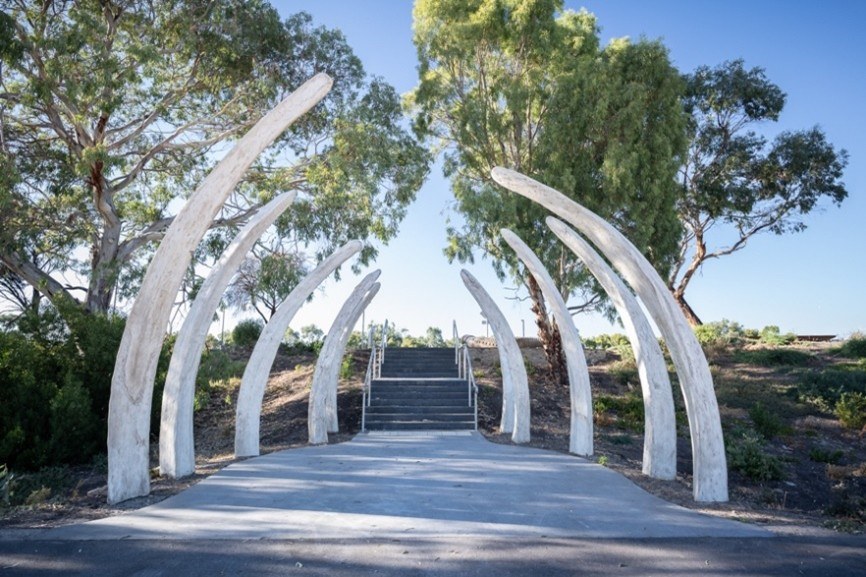
This sculpture describes a powerful representation of the deep connection between the Kaurna and Ngarrindjeri peoples and their coastal environment. It highlights their sustainable relationship with the land and sea, using elements of their language and cultural practices to create artwork that is both symbolic and functional.
The Kaurna word 'wardli' for shelter reflects the traditional dwellings that were integral to the daily life of the Kaurna people. These shelters, often constructed from natural materials, would have been built in harmony with the landscape. The whale bones, or kuntuli, in the sculpture serve as a poignant symbol of the ocean and its life-giving resources. Whales were a significant part of the coastal ecosystem, providing not only food but also spiritual and cultural connections for the people living along the coast.
The inclusion of the Kaurna shield design, with its terms murlapaka and wakalti, further enriches the artwork. These shields were not just protective tools but also held cultural significance, often decorated with unique designs that conveyed identity and belonging. The presence of these words in the sculpture ties the piece to both the Kaurna heritage of the past and their ongoing cultural presence.
This sculpture, then, is not just a representation of Kaurna life on the coast, but a testament to the interconnectedness of people, language, and the natural world. It offers a tangible link to the ancestors, a visual embodiment of stories, and an important reminder of the cultural and spiritual relationships that shape the lives of the Kaurna and Ngarrindjeri peoples.